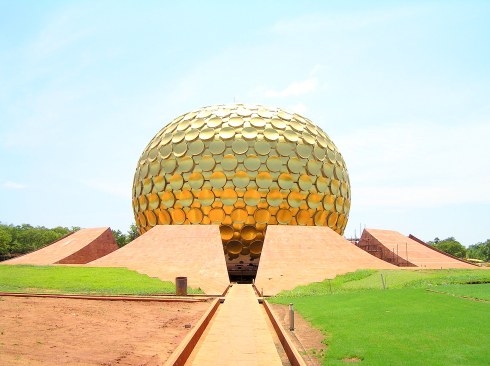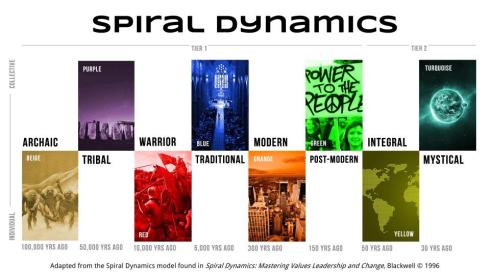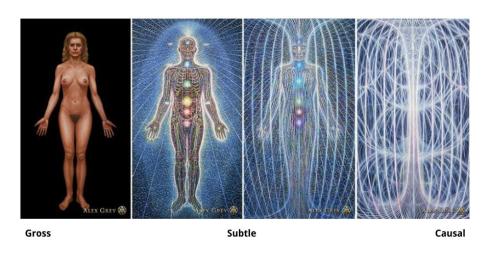
Matrimandir (Shrine to the Mother) at Auroville, India
1883 – German philosopher and critic, Friedrich Nietzsche (1844-1900), begins proposing, in Also sprach Zarathustra, that a new post-metaphysical, pro-body spirituality for the whole planet must be produced by people who have traversed nihilism, romanticism and relativism and discovered the valuing-principle common to all perspectives.
1906 – Rudolf Steiner (1861-1925), an Austrian philosopher and architect influenced by Goethe, Theosophy and Esoteric Cosmology, comments on the “integral evolution of man” during a lecture in Paris.
“The grandeur of Darwinian thought is not disputed, but it does not explain the integral evolution of man… So it is with all purely physical explanations, which do not recognise the spiritual essence of man’s being.”
– Rudolf Steiner (Eighteen Lectures delivered in Paris, France, May 25 to June 14, 1906)
1912 – Russian philosopher and journalist P.D. Ouspensky (1878-1947) publishes Tertium Organum. This book proposes to initiate a spiritual revival of humanity through the uniting of all disciplines and perspectives using a “higher logic” of both/and.
1914 – Sri Aurobindo (1872-1950) publishes Synthesis of Yoga and The Integral Yoga, in which he intended to harmonize the paths of karma, jnana, and bhakti yoga as described in the Bhagavad Gita. It can also be considered a synthesis between Vedanta and Tantra, and even between Eastern and Western approaches to spirituality. Aurobindo also proposed a concentric hierarchy consisting of the physical, vital, mental and supramental bodies.
1914 – In Russia, Harvard sociologist Pitirim Sorokin (1889-1968) began referring to the emergence of a future, spiritually-based integral society and began using phrases like “integral philosophy” and “integralist.”
1915 – Following his break with Sigmund Freud (1856-1939) over spirituality and the collective unconscious, Swiss psychiatrist and psychotherapist Carl Jung (1875-1961) begins to record his experiments with trans-rational mysticism in his famous Red Book.
1922 – French philosopher and Jesuit priest, Pierre Teilhard de Chardin (1881-1955) introduces the concept of the “noosphere” (an emerging layer of consciousness that envelops the Earth) in his Cosmogenesis. According to Vladimir Vernadsky (1863-1945), the noosphere is the third stage in the earth’s development, after the geosphere (inanimate matter) and the biosphere (biological life). Just as the emergence of life fundamentally transformed the geosphere, the emergence of human cognition will fundamentally transform the biosphere.
1922 – G.I. Gurdjieff (1866-1949) sets up his Institute for the Harmonious Development of Man outside Paris. It is an internationally renown spiritual training facility which deals with multiple lines of development and perspectival multiplicity of the human psyche. It employs a special language organized by “evolution” and “relativity.”
1926 – The Mother (Mirra Alfassa, 1878-1973) becomes the spiritual leader of the Sri Aurobindo Ashram in Auroville, India.
1940 – Indra Sen (1903-1994), a student and devotee of Sri Aurobindo, first coins the term “Integral Psychology” (contrasted with Western Psychology) and develops themes of “integral culture” and “integral man.”
1945 – British writer Aldous Huxley (1894-1963) releases The Perennial Philosophy, an attempt to present the “highest common factor” of all theologies by assembling passages from the writings of saints and prophets who approached a direct spiritual knowledge of the Divine.
1949 – The Ever-Present Origin is published by Swiss linguist and philosopher, Jean Gebser (1905-1973), describing human history as a series of mutations in consciousness. The book introduces the idea of “structures of consciousness” – archaic, magical, mythical, mental and integral/aperspectival.
1951 – Theologian and Stanford University Professor Frederick Spiegelberg (1897-1994) along with British-born poet philosopher Alan Watts (1915-1973) reach out to Sri Aurobindo in India to recommend someone “well versed in Eastern and Western philosophies with a deep knowledge of integral yoga” to help them found the American Academy of Asian Studies in San Francisco. Aurobindo appoints Dr. Haridas Chaudhuri (1913-1975) to travel to San Francisco. Integral Spirituality is officially planted in the United States.
“Spiegelberg’s phrase “the religion of no religion” had deep existential roots. It was based on a mystical encounter with the natural world he experienced as a young theology student. He was walking in a wheat field on a bright day when, quite suddenly, his ego vanished and what he calls the Self appeared. Through this altered perspective, he began to see that God was shining through everything in the world, that everything was divine, that there was nothing but holiness. As he reveled in this revelation, he came around a corner and found himself confronting a gray church. He was horrified. How, he asked himself, could such a building claim to hold something more sacred, more divine, than what he had just experienced in the poppies, birds, and sky of the now divinized cosmos? It all seemed preposterous, utterly preposterous, to him. From the theological scandal of this initial altered state, Spiegelberg developed and theorized what was essentially (or non-essentially) an apophatic mystical theology that approaches religious language, symbol, and myth as non-literal projective expressions of some deeper metaphysical truth that, paradoxically, is simultaneously immanent and transcendent—a kind of dialectical or mystical humanism, if you will. It was just such a comparative mystical theology grounded in the natural world, and just such a critical but deep engagement with the religious traditions of the world, that inspired Murphy and his colleagues in their new venture.” – Jeffrey Kripal, Esalen: America and the Religion of No Religion
1955 – Teilhard de Chardin posthumously publishes the controversial The Phenomenon of Man. Borrowing from Huxley, Teilhard describes humankind as “evolution becoming conscious of itself.” The book also introduces the concept of the Omega Point – a culmination of Supreme Consciousness.
1957 – Alan Watts publishes The Way of Zen, a synthesis of Eastern and Western spiritualites as well as General Semantics and Cybernetics.
1960 – Teilhard de Chardin releases The Divine Milieu to synthesize theology and science and demonstrate that “secular (scientific) work was an integral element of creation.”
1962 – Influenced by Huxley’s studies of “human potentiality,” Michael Murphy (1930-), Dick Price (1930-1985) and Spiegelberg establish the Esalen Institute (a retreat center and intentional community) on 120 acres of the Big Sur coast in California.
1967 – Hungarian-born author and journalist Arthur Koestler (1905-1983) introduces the concept of holons (something that is simultaneously a whole and a part) in The Ghost in the Machine. Holons exist as self-contained wholes in relation to their sub-ordinate parts, and dependent parts when considered from the inverse direction. Continue reading







 e’ve hit a glass ceiling.
e’ve hit a glass ceiling.
 ou know that moment when the sand at the bottom of the hourglass starts to cave in toward the center? And it seems like suddenly the grains start to quicken, to pick up speed. But it’s an illusion, right? They don’t really move any faster, do they? Time doesn’t speed up if we have less of it. Or does it?
ou know that moment when the sand at the bottom of the hourglass starts to cave in toward the center? And it seems like suddenly the grains start to quicken, to pick up speed. But it’s an illusion, right? They don’t really move any faster, do they? Time doesn’t speed up if we have less of it. Or does it?

